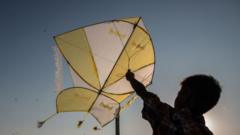Who Will Conquer Indonesia's Skies: Planes or Kites?

The Kite-Flying Culture of Indonesia: A Balancing Act between Tradition and Safety
In Indonesia, where vibrant traditions and modern challenges often collide, kite flying stands out as a beloved pastime. The scene described at a paddy field near Jakarta’s international airport captures this cultural phenomenon perfectly. Children tug at colorful kite strings, their laughter mingling with the roar of airplanes above. Yet, beneath this joyful activity lies a significant tension: the looming threat of safety regulations aimed at preventing kite-related incidents that could jeopardize air travel.
Kite Flying: A Cherished Tradition
Kite flying has deep roots in Indonesian culture. Traditionally crafted from materials like leaves, paper, or cloth, kites are flown during various occasions, including rice harvest ceremonies, to ward off birds from crops, and as offerings to the gods in places like Bali. The craft has been passed down through generations, making it an integral part of the cultural fabric in nearly every region of Indonesia.
However, as modernity encroaches on these age-old practices, the safety concerns associated with kite flying, especially near airports, have prompted authorities to take action. The juxtaposition of a cherished childhood pastime and the stringent regulations aimed at ensuring public safety creates a complex narrative that challenges both the enthusiasts and the authorities involved.
The Impact of Urbanization on Kite Flying
Urbanization in Indonesia has had a profound impact on the availability of open spaces for recreational activities, including kite flying. Between 2000 and 2020, Jakarta experienced a staggering loss of 31% of its urban green spaces, leading to fewer locations for children and families to fly kites. As fields and forests give way to congested roads and towering apartment blocks, the paddy field near Soekarno-Hatta Airport has become one of the few remaining havens for kite enthusiasts. This scarcity of space intensifies the conflict between the joy of kite flying and the potential risks it poses to air traffic.
Safety Concerns and Government Response
The Indonesian government has recognized the risks associated with kite flying near airports. With reports of kites interfering with aircraft operations leading to flight disruptions, authorities have taken measures to mitigate these dangers. For instance, during a three-day period in July, kites caused disruptions to 21 flights at Soekarno-Hatta International Airport, forcing some planes to divert and others to abort landings. Such incidents have prompted officials like Putu Eka Cahyadi, head of the airport authority, to label kites as “moving obstacles” and a “serious risk to flight safety.”
Tragic Incidents Highlighting the Risks
While the thrill of flying kites captivates many, tragic incidents underline the need for caution. In July 2024, a helicopter crash in Bali, resulting from entanglement with kite strings, injured five individuals, raising alarms about the dangers posed by kites. Similarly, a 2020 incident where bamboo sticks and strings from a kite were discovered in a plane's engine further illustrated the potential hazards. In response, the airport established a task force aimed at curbing kite flying in the vicinity.
Community Response and Adaptation
Despite the risks, the passion for kite flying persists among the local community. Children like Atif and Rasha express their love for this time-honored tradition, often disregarding the rules put in place by authorities. Rasha, a 17-year-old kite maker and competitor, shared his experiences of both triumph and conflict with the authorities, revealing a complex relationship with a hobby that is both culturally significant and perilous. “There’s nowhere else around here,” he says, reflecting the need for safe spaces to continue this tradition.
Efforts to Redirect Interests
In an attempt to redirect the interests of children away from kite flying, authorities have experimented with introducing alternative recreational activities, such as football and badminton. However, the cultural significance of kite flying makes it difficult for many to abandon this beloved pastime. Efforts to educate the younger generation about the potential dangers of flying kites near airports have been met with mixed responses, highlighting the challenge of balancing tradition with safety.
Conclusion: A Call for Balance
The story of kite flying in Indonesia is more than just a tale of childhood joy; it is a narrative steeped in tradition, cultural pride, and the complexities of modern life. The challenge lies in finding a balance between preserving a cherished cultural practice and ensuring safety in an increasingly crowded and urbanized environment. While kite flying brings joy to many, it also demands respect for the potential dangers it poses, particularly in proximity to air travel.
As we consider the future of kite flying in Indonesia, it raises a thought-provoking question: How can we honor and preserve cultural traditions while prioritizing the safety of our communities?
FAQs
What materials are traditionally used to make Indonesian kites?
Indonesian kites are traditionally crafted from materials such as leaves, colorful paper, and cloth, allowing for a wide range of designs and artistic expressions.
What safety measures are in place for kite flying near airports?
Authorities have implemented strict regulations prohibiting kite flying near airports. Offenders may face penalties, including fines and potential jail time, to ensure safety for air traffic.
How has urbanization affected kite flying in Indonesia?
Urbanization has led to a significant reduction in open spaces for recreational activities. This has made it increasingly difficult for kite enthusiasts to find safe locations to fly their kites.
As kite flying continues to be a source of joy and cultural significance in Indonesia, how can we find innovative solutions to maintain this tradition while ensuring safety in our communities? #KiteFlying #IndonesianCulture #SafetyFirst
```Published: 2025-08-02 05:01:26 | Category: world



